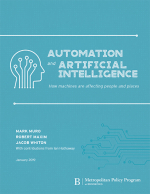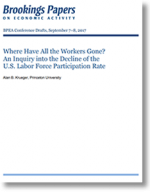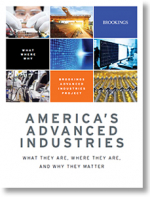Where Have All the Workers Gone?
This paper is "An Inquiry into the Decline of the U.S. Labor Force Participation Rate" from the BPEA Conference Drafts, September 7-8, 2017.
The labor force participation rate in the U.S. has declined since 2007 primarily because of population aging and ongoing trends that preceded the Great Recession.
The participation rate has evolved differently, and for different reasons, across demographic groups.
A rise in school enrollment has largely offset declining participation for young workers since the 1990s.
Participation in the labor force has been declining for prime-age men for decades, and about half of prime-age men who are not in the labor force (NLF) may have a serious health condition that is a barrier to work.
Nearly half of prime-age NLF men take pain medication on a daily basis, and in nearly two-thirds of these cases, they take prescription pain medication.
Labor force participation has fallen more in areas where relatively more opioid pain medication is prescribed, causing the problem of depressed labor force participation and the opioid crisis to become intertwined.
The labor force participation rate has stopped rising for cohorts of women born after 1960.
Prime age men who are out of the labor force report that they experience notably low levels of emotional well-being throughout their days and that they derive relatively little meaning from their daily activities.
Employed and NLF women, by contrast, report similar levels of subjective well-being, but NLF women who are not primarily taking care of home responsibilities report notably low levels of emotional well-being.
Over the past decade, retirements have increased by about the same amount as aggregate labor force participation has declined, and the retirement rate is expected to continue to rise.
A meaningful rise in labor force participation will require a reversal in the secular trends affecting various demographic groups, and perhaps immigration reform.
What’s Related




Favorites





